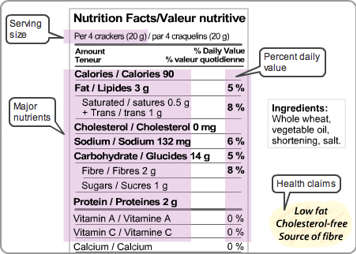Nutrition facts tables and food labels help you learn more about your food and make healthy choices after your transplant. It is worth taking some time to learn how to read them.
Serving size
All information on in a nutrition facts table is based on a specific amount of food.
The serving size says how much is in a single portion of food. The rest of the information is for that serving size. If you are eating a larger or smaller amount of the food, use the nutrition facts to work out the nutrients for the portion you are going to eat.

When you are comparing the nutrients in two similar foods, make sure the serving sizes are the same.
Here’s an example:
| Canned Soup A | Canned Soup B |
| Serving size - 125 mL | Serving size - 250 mL |
| Fibre 2 g | Fibre 2 g |
Which canned soup has more fibre?
Answer: Canned Soup A.
To compare the two soups correctly, the serving sizes must be the same. If you double the serving size of Canned Soup A to 250 mL (to match Canned Soup B), the amount of fibre will also double, to 4 grams.
Percent daily value
The % daily value (DV) is a simple way to find out if a food has a little or a lot of a nutrient. The % DV is based on recommendations for a healthy diet.
- 5% DV or less is a little of that nutrient.
- 15% DV or more is a lot of that nutrient.
Aim for foods with a lower % DV for some nutrients and a higher one for others, as shown here.
| Aim for a lower % DV | Aim for a higher % DV |
| Fat | Fibre |
| Saturated and trans fat | Vitamin A |
| Sodium | Vitamin C |
| Iron | |
| Calcium |
Calories
Carbohydrate, protein and fat all have calories. It is important to look at the calorie content of food, especially if you are eating a low-fat or low-carbohydrate diet. Consuming too many calories, no matter which foods they come from, could lead to weight gain.
Total fat, saturated fat, cholesterol and trans fat
Saturated and trans fats are considered “bad” fats because they can increase the levels of “bad cholesterol” in the blood and raise your risk of heart disease. Cholesterol is in all foods made from animal products.
When comparing foods using the nutrition label:
- choose foods that are lower in total fat
- choose foods with lower amounts of cholesterol
- look for foods that contain less than 2 grams of saturated and trans fat in total per serving
- choose foods that are “trans fat free”, as they are even healthier choices.
While all these fats are bad, saturated and trans fats are more strongly linked to heart disease than cholesterol is.
Sodium
Foods such as French fries, ready-to-eat dinners, soup and many snack foods contain large amounts of sodium. When comparing foods using the nutrition facts table, choose foods with lower amounts of sodium.
Carbohydrates, fibre and sugars
Carbohydrates provide energy to your muscles and brain. Whole grain sources of carbohydrate are more nutritious than refined sources (such as white sugar and syrup). This is because whole grains contain more fibre and other vitamins and minerals.
Fibre also helps to relieve constipation, manage blood sugars, decrease “bad” cholesterol and manage your weight. It may also reduce the risk of colon cancer.
When comparing foods using the nutrition facts table:
- choose foods high in fibre (more than 2 g per serving)
- choose foods that are lower in sugar (less than 8 g added sugar per serving).
Only have small amounts of products that contain sweeteners such as aspartame, sucralose, saccharin and sugar alcohols.
Protein
Protein helps our muscles, organs and immune system work properly. Choose a variety of protein-rich foods such as legumes (beans and peas), milk products, nuts, eggs, soy products, fish and lean meat or poultry.
Ingredients
Ingredients are listed in order of weight, from the largest to the smallest amount. When an ingredient appears near the start of the list, there is a lot of it in the food.
Remember too that one type of ingredient can be listed several times using different words. For example, sucrose, glucose, fructose, dextrose, corn syrup and honey are all different forms of sugar.
Whenever possible, choose products that contain the least amount of ingredients.
Health claims
Health claims, such as “High in fibre” or “Good source of calcium”, help us make informed choices about the product. But be sure to check the nutrition facts table to see if the claims are true! For instance, a product will sometimes claim that it is a source of fibre, but it might only contain a very small amount and may also contain many ingredients that are not good for you.






